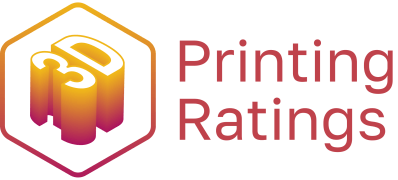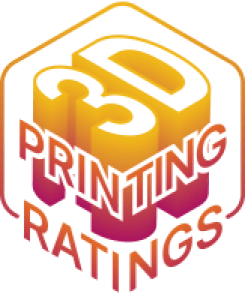Anet ET4
The Anet ET4 is Anet’s newest 3D printer in the race. This machine is not only modern, but it also has a clean all-metal design and a 2.8-inch touchscreen. The printer is an all-metal FDM 3D printer that is mostly assembled and is made of an industrial-grade 32bit motherboard. It has a more stable and compact construction design and supports auto-leveling, resume printing, and filament detection.
Some fantastic features set the Anet ET4 apart, and here is a list of them:
1. Automatic Filament Assignment And Integrated Modular Design
Unlike other 3D printers that require a lot of manual labor to load and unload filament, the Anet ET4 allows you to do it all with a single click. Loading and unloading filament can be easily done by clicking on the touchscreen interface.
ET4’s overall design is not only appealing but is also well integrated and optimized for construction and arrangement.
Connection ports, covered wires, and a sleeker appearance are all part of the modular design with the terminal pinboard.
2. Optional Trinamic Motor Drivers and 2.8 inches Touchscreen Interface
Anet sells 256-micro stepping Trinamic Drivers for around $15, which can be purchased separately from the 3D printer.
The ET4 will be “almost silent” when using these drivers, according to the printer manufacturer, even when 3D printing at full speed. This is a special feature compared to other printers in the same price range.
It is because you, as a user, are frustrated when fine-tuning your settings with a fiddly plastic knob. Many 3D printers that cost a lot of money come with a knob. With the E4, however, this is not the case.
3. Filament Detection Sensor and Power Outage Recovery
Before reaching the Bowden-type extruder, the filament of Anet ET4 enters two systems:
- A filament runout sensor that displays an on-screen message asking for new material.
- Transporter of the filament to the extruder
The Anet ET4 detects when you run out of filament and saves your print progress in the event of a power outage. Filament detection detects the end of the filament and sends reminders so that air-printing is avoided. The printer allows you to resume printing and pick up right where you left off. Therefore, you do not have to be concerned about power outages.
Even if the power goes out while you are in the middle of 3D printing a part or functional prototype, your work progress will be saved in the Anet ET4.
4. All Metal Construction
The Anet ET4 appears to have no wires connecting the various parts of the printer at first glance.
The electronics are tucked neatly inside a sturdy sheet-metal control box beneath the print bed, thanks to the printer’s manufacturer.
As a result, the printer is simple to assemble, making it a pleasant setup experience for beginners.
5. Auto-leveling
Auto-leveling is something that is becoming more and more common in low-cost FDM machines these days, and Anet has included it in ET4 as well.
The machine, which uses a probe mounted beside the extruder to measure 25 points across the print bed, theoretically compensates for deviations.
When you have an uneven bed, this arrangement will help you and ensure better first-layer performance across the 220 x 220 mm print area.
You will get precise first-layer prints with the printer’s automatic bed leveler, improving the final print’s quality.
Auto-leveling also reduces the amount of human work. As a result, the printer’s output efficiency improves.
Specifications:
- Power Supply: 110V AC 240W
- Structure: Sheet Metal Frame
- Printing Technology: FDM
- Extruder Quantity: 1
- Printing Size: 220x220x250mm
- Printing Resolution: 0.1mm
- Layer Thickness: 0.1-0.3mm
- Connection Mode: Online/Offline Printing
- LCD Display: 2.8 Inch Touchscreen
- Movement Speed: </=150mm/s
- Printing Speed: 20-150mm/s(recommended speed 30/60mm/s
- Standard Nozzle Diameter: 0.4mm
- Extruder Working Temperature(Max): 250°C
- Hotbed Temperature(Max): 100°C
Anet ET4 Pro
The new Anet ET4 Pro is a minor upgrade over the previous ET4. The addition of TMC2208 stepper motor drivers is the highlight of the upgrades. The remainder of the changes is minor when the Anet 3D Printer Comparison is done between the ET4 and ET4 Pro. Let’s dig into the features that set the Anet ET4 Pro apart from the ET4.
1. TMC2208 Stepper Driver
Already available as a drop-in upgrade for the ET4, Anet’s ET4 Pro does the heavy lifting for you with TMC2208 stepper motor drivers as standard. It is something you would want for your new 3D printer in an ideal world, keeping things humming along quietly and micro-stepping for smoother prints, so we can see why Anet is now including it as part of the complete package.
2. Automatic Bed Levelling
We all favor things that make life easier, and automatic bed leveling is one of them. It is a pain fiddling with knobs to get the right level, so the fact that the Anet ET4 Pro – like the ET4 – does it for you is a welcome addition.
3. Easy To Assemble
Almost every 3D printer now comes partially assembled. The ET4 Pro is not the same as Anet’s previous A8 printer. While standing at the time, a full-kit printer was so complicated that you could have built your stealth fighter in the shed faster than you could have set up the A8 using the instructions provided. Thankfully, things have progressed, and Anet claims that once you receive the ET4 Pro, you can set it up in under 10 minutes.
4. Cosmetically Enhanced
The Anet ET4 Pro, which is newer than the ET4, has a more mature appearance than the ET4. Its “Blackout” color scheme gives it a more serious aura, an improvement over the ET4’s red-touched face.
Apart from these, all other features and specifications are the same with the Anet ET4 as reeled out above.
Properties
- Build volume: 220 x 220 x 250 mm
- Feeder system: Bowden
- Print Head: Single nozzle
- Nozzle size: 0.4 mm
- Max. hot end temperature: 250 ℃
- Max. heated bed temperature: 100 ℃
- Print bed material: Glass
- Frame: Aluminum
- Bed leveling: Automatic
- Connectivity: USB, SD Card, Ethernet
- Print recovery: Yes
- Filament sensor: Yes
- Camera: No
Materials
- Filament diameter: 1.75 mm
- 3rd party filaments: Yes
- Compatible materials: Consumer materials (PLA, ABS, PETG, Flexibles)



